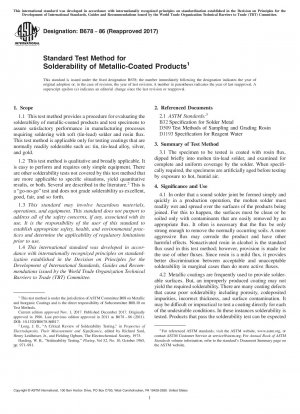ASTM B678-86(2017)
Standard Test Method for Solderability of Metallic-Coated Products
- Standard No.
- ASTM B678-86(2017)
- Release Date
- 1986
- Published By
- American Society for Testing and Materials (ASTM)
- Status
- Replace By
- ASTM B678-23
- Latest
- ASTM B678-23
- Scope
-
4.1 In order that a sound solder joint be formed simply and quickly in a production operation, the molten solder must readily wet and spread over the surfaces of the products being joined. For this to happen, the surfaces must be clean or be soiled only with contaminants that are easily removed by an appropriate flux. It often is necessary that the flux be only strong enough to remove the normally occurring soils. A more aggressive flux may corrode the product and have other harmful effects. Nonactivated rosin in alcohol is the standard flux used in this test method; however, provision is made for the use of other fluxes. Since rosin is a mild flux, it provides better discrimination between acceptable and unacceptable solderability in marginal cases than do more active fluxes.
4.2 Metallic coatings are frequently used to provide solderable surfaces. But, an improperly produced coating may not yield the required solderability. There are many coating defects that cause poor solderability including porosity, codeposited impurities, incorrect thickness, and surface contamination. It may be difficult or impractical to test a coating directly for each of the undesirable conditions. In these instances solderability is tested. Products that pass the solderability test can be expected to solder satisfactorily in production. In the case of failure to pass the test, the test results will not reveal the cause of the inadequate solderability, though, with experience, an operator may be able to identify the cause.
4.3 This test method measures the ability of a coated product to be soldered with 60/40 tin/lead solder using a nonactivated rosin flux. This solder and this flux, or an activated form of it, are generally used in the assembly of electronic products.
4.4 It is intended that the tested specimens be components of electronic products or articles with the same general shape and mass. Articles that are much more massive than this will heat up too slowly during the solder immersion. If more massive specimens are to be tested, a longer immersion time will have to be used, the time to be determined by experiment.
4.5 If the specimen tested is longer than 25 mm, its bottom end will be in the solder for significantly longer than the specified time. Therefore, if the specimen is longer than 25 mm, the results obtained at the bottom end of the specimen are invalid. This part of the specimen shall be discounted in the evaluation of the results. A second set of tests can be run on additional specimens in which the specimens are only partly immersed. These would be used to evaluate the bottom ends.
1.1 This test method provides a procedure for evaluating the solderability of metallic-coated products and test specimens to assure satisfactory performance in manufacturing processes requiring soldering with soft (tin-lead) solder and rosin flux. This test method is applicable only for testing coatings that are normally readily solderable such as: tin, tin-lead alloy, silver, and gold.
1.2 This test method is qualitative and broadly applicable. It is easy to perform and requires only simple equipment. There are other solderability tests not covered by this test method that are more applicable to specific situations, yield quantitative results, or bo......
ASTM B678-86(2017) Referenced Document
- ASTM B32 Standard Specification for Solder Metal*, 2020-10-01 Update
- ASTM D1193 Standard Specification for Reagent Water*, 1999-04-20 Update
- ASTM D509 Standard Test Methods of Sampling and Grading Rosin*, 1998-04-20 Update
ASTM B678-86(2017) history
- 2024 ASTM B678-23 Standard Test Method for Solderability of Metallic-Coated Products
- 1986 ASTM B678-86(2017) Standard Test Method for Solderability of Metallic-Coated Products
- 1986 ASTM B678-86(2011) Standard Test Method for Solderability of Metallic-Coated Products
- 1986 ASTM B678-86(2006) Standard Test Method for Solderability of Metallic-Coated Products
- 1986 ASTM B678-86(2001) Standard Test Method for Solderability of Metallic-Coated Products
- 1986 ASTM B678-86(1993) Standard Test Method for Solderability of Metallic-Coated Products

Copyright ©2024 All Rights Reserved